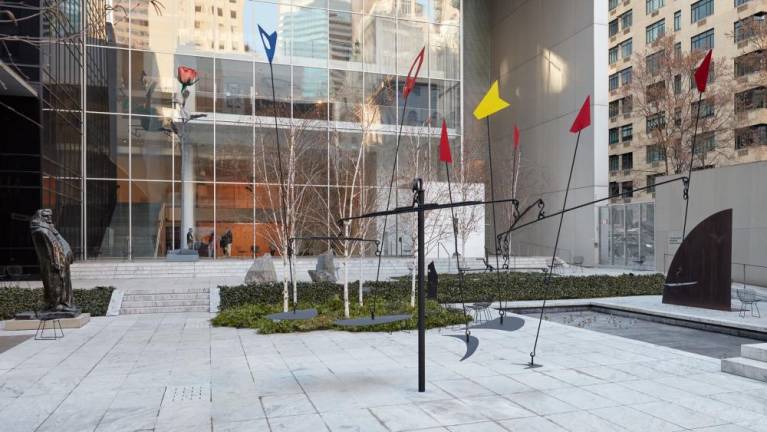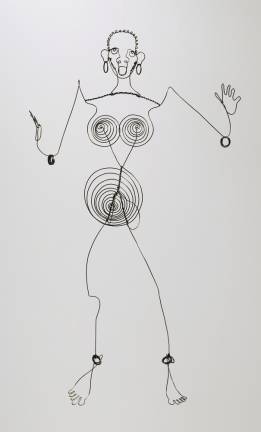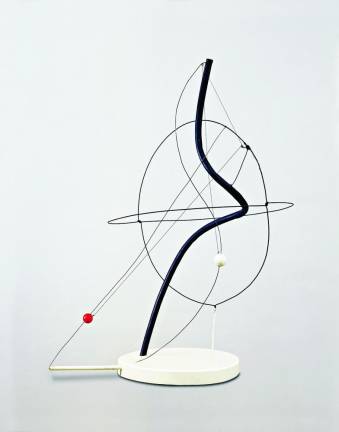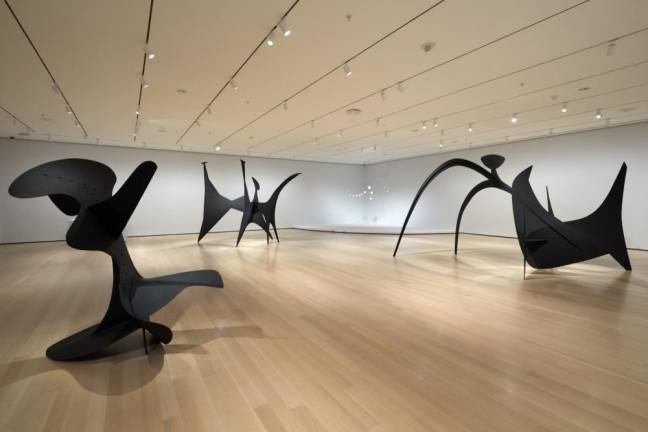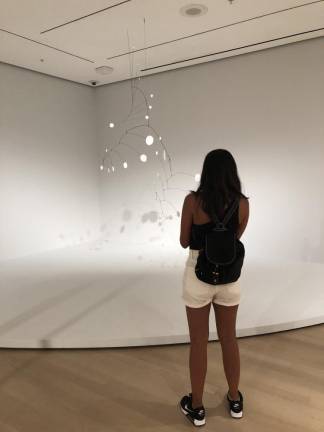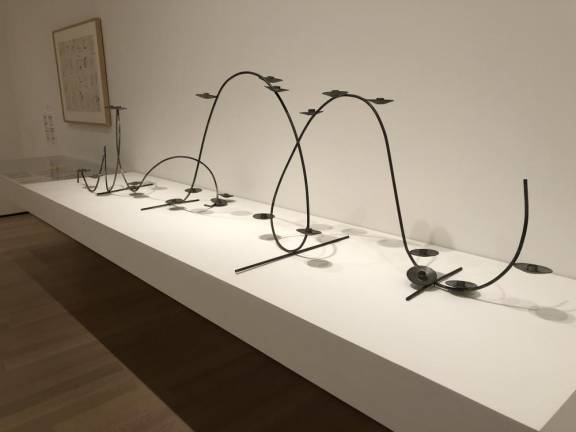Alexander Calder (1898-1976) had a decades-long history with MoMA, the organizing principle behind its latest exhibit of the American artist’s iconic sculptures on the third floor and in the Sculpture Garden. He was the rough equivalent of artist-in-residence after the museum’s founding in 1929 and through the war years, and he remains a palpable presence to this day. His mobile “Lobster Trap and Fish Tail” (1939) still hangs in the same stairwell for which it was commissioned when the Philip L. Goodwin and Edward Durell Stone building opened in 1939.
The show, some 70 artworks from MoMA’s collection and the Calder Foundation, unfolds across three galleries and concludes with the newly conserved “Man-Eater with Pennants” (1945) plus “Sandy’s Butterfly” (1964) in the garden, a colorful coda that is at once surprising but not surprising because the garden has long been home to Calder’s large-scale abstract sculptures.
“Black Widow” (1959), a monumental piece in painted sheet metal, was exhibited en plein air before it was moved inside to the first room here, where it joins several other massive abstractions in black and packs a wallop.
Happily, the curators are less concerned with chronologies and timelines and more intent on letting viewers experience the works, taking their cue from the artist himself, who, in fact, wanted most of his sculptures to be lived with — touched and engaged with at home — not put on a pedestal in a museum, where touching is prohibited and viewers are cautioned to distance themselves from the art.
Before his mid-career retrospective at MoMA in 1943, Calder drew a double-sided picture of his major nonobjective works, a kind of DIY catalog [“Unititled” (recto and verso), 1943] — a rare document on display here for the first time.
As his grandson and president of the Calder Foundation, Alexander (“Sandy”) Rower, writes in the exhibit catalog, the artist’s sculptures from 1931 to 1942 “cover a range of entirely new and radical objects ... stabiles, motorized mobiles, standing mobiles, hanging mobiles, wall sculptures, large-scale outdoor works.” Much like the selections for this show, which also includes jewelry, works on paper, archival material and candelabra that could be mistaken for a roller coaster.
In the 1920s in Paris, where he mixed with the avant-garde likes of Marcel Duchamp and Piet Mondrian, Calder devoted himself to figural works in wood and wire — animals, human portraits and, famously, “Cirque Calder,” a mini circus with handcrafted characters and apparatus that he first operated in his studio for friends.
Bent Wire
No circus here, but the second gallery, a narrow corridor, pays homage to Calder’s early experimentations with bent wire to capture personalities (e.g., “Josephine Baker III,” c. 1927) and members of the animal kingdom. There’s a steel-wire cow (“Cow,” c. 1929) with three “pies that sit under the cow’s posterior,” curator Cara Manes discreetly notes in a Virtual Views video on MoMA’s website, evidence of the artist’s legendary humor and playfulness.
But depictions of cow flop and the natural world gave way to an obsession with abstraction after a visit to Mondrian’s studio in Paris in 1930, a few weeks before MoMA’s seminal show, “Painting and Sculpture by Living Americans,” which featured Calder’s representational art at the very moment that he had decided to abandon it.
He entered Mondrian’s studio — a completely abstract space, with a wall covered in colored rectangles that could be rearranged to create a new dynamic — and was hooked.
“This one visit,” Calder wrote in his autobiography about his aha moment, “gave me a shock that started things. Though I had heard the word ‘modern’ before, I did not consciously know or feel the term ‘abstract’.”
He determined not to mimic the world around him any more, but to create artworks that were worlds unto themselves, Manes writes. And it is through that lens that his abstract works should be seen, though Calder insisted his art had no meaning; it was purely experiential.
Signature Mobiles
In the motorized “A Universe” (1934), the red sphere may look like the sun, and the white one may look like the moon, but they represent neither despite what the critics said. It’s an alternative universe, and you are invited.
“Calder wanted to provide an opportunity for you to get to something more real than this cloudy haze we call life,” grandson Sandy Rower states in a video on MoMA’s website.
He rejected the notion that sculpture had to be made of marble or bronze and be dense and anchored to the ground. He was interested in movement and volume and space. His signature mobiles, whether hanging or earth bound, move freely, buffeted by air currents, human contact and gentle vibrations. They are never the same; the reset button is always in play.
“Snow Flurry I” (1948), a hanging mobile in the corner of the first gallery with circular white disks attached to wire, makes the case.
“It moves as my grandfather intended,” Rower says in the Virtual Views Q & A with the curator, “which is each different constellation, each different group of elements, each different sort of movement, almost like it’s music, has its own attitude and its own spirit.”
With virus fears spiraling again, it seems like there’s no better time to enter Calder’s universe and be spirited away.
“Alexander Calder: Modern from the Start” at The Museum of Modern Art, 11 West 53rd Street (between Fifth and Sixth Avenues); through January 15, 2022.
